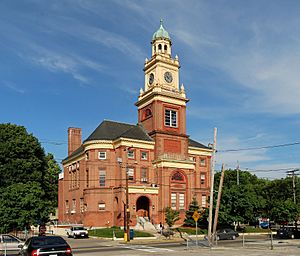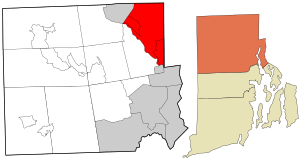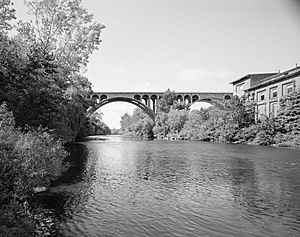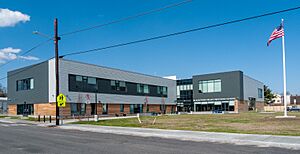Cumberland, Rhode Island facts for kids
Quick facts for kids
Cumberland, Rhode Island
|
|
|---|---|

Cumberland Town Hall
|
|
| Motto(s):
Great History. Bright Future
|
|

Location in Providence County and the state of Rhode Island.
|
|
| Country | United States |
| State | Rhode Island |
| County | Providence |
| Settled | 1635 |
| Incorporated | 1746 |
| Area | |
| • Total | 28.3 sq mi (73.2 km2) |
| • Land | 26.4 sq mi (68.5 km2) |
| • Water | 1.8 sq mi (4.7 km2) |
| Elevation | 276 ft (84 m) |
| Population
(2020)
|
|
| • Total | 36,405 |
| • Density | 1,288.1/sq mi (497.3/km2) |
| ZIP code |
02864
|
| Area code(s) | 401 |
| FIPS code | 44-20080 |
| GNIS feature ID | 1220068 |
Cumberland is a town in Rhode Island, located in the northeastern part of Providence County. It was first settled in 1635 and became an official town in 1746. In 2020, about 36,405 people lived there, making it the seventh-largest town in Rhode Island.
Contents
History of Cumberland
Cumberland was first part of Wrentham, Massachusetts. This land was bought from local Native American tribes. Later, it became part of Rhode Island after a long disagreement about the border. The town was named after Prince William, Duke of Cumberland.
Early Settlers and Important Places
William Blaxton was the first European to live in Cumberland. He had also lived in Boston but left because he disagreed with the Puritans about religion. He taught his beliefs under a large oak tree. He lived on a farm in Lonsdale, where he grew the first type of American apples, called Yellow Sweeting. His home's location is now where the Ann & Hope mill stands.
A popular place to visit is "Nine Men's Misery." It's a tomb on the land of a former monastery. Part of the monastery was turned into the Edward J. Hayden Library, which is now the Cumberland Public Library. This happened in 1976 and brought three smaller libraries together.
Industry and Business Growth
Cumberland was important for making iron. Iron works here created cannons and cannonballs for the French and Indian War and the American Revolution. The Valley Falls Company, which started in Cumberland and nearby towns, is now part of Berkshire Hathaway. This is one of the biggest and most successful companies in the world.
A machine shop in Cumberland made the first power looms for wool in America. These machines were used in a mill in Uxbridge around 1820.
Cumberland is also where the Ann & Hope discount store chain began in 1955. It claims to be the first chain of discount department stores in America.
The town is in the lower Blackstone Valley of Rhode Island. This area is part of the John H. Chafee, Blackstone River Valley National Heritage Corridor, a historic National Park area.
Recent Events and Achievements
In 1980, a student at Cumberland High School was not allowed to bring a same-sex date to prom. A federal court ruled that this went against the student's free speech rights. This was an important early legal victory for student rights.
The Cumberland American Little League baseball team won the New England Regional Championship in 2011 and 2014. They then played in the Little League World Series both times.
Geography of Cumberland
Cumberland covers about 73.2 square kilometers (28.3 square miles). Most of this is land (68.5 square kilometers or 26.4 square miles), and 4.7 square kilometers (1.8 square miles) is water.
Cumberland is the easternmost town along Rhode Island's northern border with Massachusetts. It borders Woonsocket and Central Falls in Rhode Island. It also borders Wrentham, Plainville, North Attleborough, and Attleboro in Massachusetts.
Unique Natural Features
The official state rock of Rhode Island is Cumberlandite. This rare, iron-rich mineral is found mostly in northern Cumberland. In the past, this ore was used to make cannons, but the cannons often cracked.
Another important natural feature is Diamond Hill. This is a huge rock formation made of white quartz. Diamond Hill used to have two small ski areas and is now a town park.
Population Information
| Historical population | |||
|---|---|---|---|
| Census | Pop. | %± | |
| 1790 | 1,964 | — | |
| 1800 | 2,056 | 4.7% | |
| 1810 | 2,210 | 7.5% | |
| 1820 | 2,653 | 20.0% | |
| 1830 | 3,675 | 38.5% | |
| 1840 | 5,225 | 42.2% | |
| 1850 | 6,661 | 27.5% | |
| 1860 | 8,339 | 25.2% | |
| 1870 | 3,882 | −53.4% | |
| 1880 | 6,445 | 66.0% | |
| 1890 | 8,090 | 25.5% | |
| 1900 | 8,925 | 10.3% | |
| 1910 | 10,107 | 13.2% | |
| 1920 | 10,077 | −0.3% | |
| 1930 | 10,304 | 2.3% | |
| 1940 | 10,625 | 3.1% | |
| 1950 | 12,842 | 20.9% | |
| 1960 | 18,792 | 46.3% | |
| 1970 | 26,605 | 41.6% | |
| 1980 | 27,069 | 1.7% | |
| 1990 | 29,038 | 7.3% | |
| 2000 | 31,840 | 9.6% | |
| 2010 | 33,506 | 5.2% | |
| 2020 | 36,405 | 8.7% | |
| U.S. Decennial Census | |||
In 2010, there were 33,506 people living in Cumberland. There were 13,143 households and 9,232 families. The average household had about 2.53 people.
The population included people of all ages. About 22.5% were under 18, and 15.8% were 65 or older. The average age was 42.5 years.
Schools in Cumberland
The Cumberland School Department manages the town's schools. A School Committee with seven members leads the department. They hire a Superintendent of Schools to manage the schools and learning programs.
Public and Private Schools
Cumberland is home to Blackstone Valley Prep, a public charter school. It opened in 2009 with Kindergarten classes. The Blackstone Valley Prep High School, a new charter school, opened in 2017.
There is one private school in Cumberland called Mercymount Country Day School. It is run by the Sisters of Mercy of the Americas, a Roman Catholic group.
Culture and Traditions
Cumberland has several fun traditions and events throughout the year.
Annual Events
The Arnold Mills Fourth of July Parade and 4 Mile Road Race happen every year to celebrate Fourth of July. The first parade was held in 1927.
Cumberlandfest is a popular event held every August at Diamond Hill Park. It has carnival rides, live entertainment, and fireworks. The money raised helps the town's athletic programs.
Local Businesses and Arts
The convenience store chain Cumberland Farms got its name from a dairy farm that started in Cumberland, Rhode Island.
The Blackstone River Theatre hosts many cultural events, especially concerts. These concerts often feature traditional music from the people who settled the Blackstone Valley. The theatre also sponsors the annual Summer Solstice Festival at Diamond Hill State Park.
Historic Farm
Historic Metcalf-Franklin Farm on Abbott Run Valley Road was the last working dairy farm in Cumberland. You can explore its open fields, old stone walls, and a traditional cow pond. The farm's barn (from the 1810s) and house (from the 1850s) are being preserved.
Notable People from Cumberland
Many interesting people have come from Cumberland:
- John Capron, Sr. (1797–1878) – A military officer, politician, and textile maker.
- Public Universal Friend (1752–1819) – A religious leader.
- Johnny Goryl – A Major League Baseball player and manager.
- Richard Jenkins – An actor known for TV shows like Six Feet Under and movies like Cheaper by the Dozen. He lives in Cumberland.
- Tyler Kolek – An NBA point guard for the New York Knicks.
- Brian Lawton – A left wing who played for several National Hockey League teams.
- David Macaulay – A British-born author and illustrator who graduated from Cumberland High School.
- Dan McKee – The 76th Governor of Rhode Island and former mayor of Cumberland.
- Cory Pesaturo – A musician and three-time world champion in accordion.
- Stephen Peterson – A rower who was on the 1996 U.S. Olympic team and won a gold medal in 1990.
- Jayden Struble – A professional ice hockey defenseman for the Montreal Canadiens.
- Pete Wells – A restaurant critic for The New York Times.
- Tim White – A referee for World Wrestling Entertainment (WWE).
- Inez Whipple Wilder (1871–1929) – A zoologist who studied fingerprints and salamanders.
- Annette Nazareth (born 1956) – A former SEC Commissioner who grew up in Cumberland.
National Registered Historic Places
These are places in Cumberland that are listed on the National Register of Historic Places:
- Arnold Mills Historic District
- Ashton Historic District
- Ballou-Weatherhead House
- Berkeley Mill Village
- Burlingame-Noon House
- John Cole Farm
- Furnace Carolina Site
- Luke Jillson House
- St. Joseph's Church Complex
- Lewis Tower House
- Tower-Flagg Barn Complex
- Whipple-Jenckes House
- Metcalf-Franklin Farm
See also
 In Spanish: Cumberland (Rhode Island) para niños
In Spanish: Cumberland (Rhode Island) para niños



